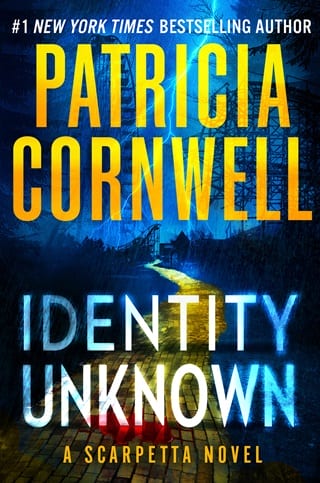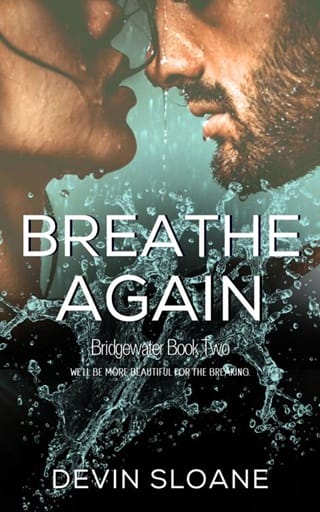Chapter 16
CHAPTER 16
W e follow Sweeney Boulevard, paralleling the runway. Another supersonic jet takes off at an impossibly steep angle, the engines whining and screaming. Flowing past are the commissary, the chapel and tidy rows of military housing, the traffic heavy at this hour. Roadsides are planted with dogwoods and cherry trees, what I’m seeing unchanged from when I was here last winter for a murder-suicide.
Over the years I’ve visited numerous bases for a variety of reasons, my connection to the military a deeply rooted one. The Air Force reserves helped make my education possible, and I had a debt to repay. After the Dade County Medical Examiner’s Office and before I moved to Richmond, I was assigned to the Armed Forces Institute of Pathology (AFIP) at Walter Reed Hospital in Bethesda, Maryland.
I reviewed military autopsies and investigated the deaths of Americans overseas. In my spare time I helped out at the AFIP’s National Museum of Health and Medicine. I wrote catalog descriptions, assisted researchers and in the process was exposed to a variety of pathological wonders. Rare birth defects. Limbs amputated during the Civil War. Fragments of Abraham Lincoln’s skull, and the bullet that killed him.
At the end of a long row of white hangars, we pick up a low-lying road that takes us around the northwest end of the airfield. Raptor jets tear up the bluing dusk, climbing and rolling, spinning and looping like Cirque du Soleil performers, the afterburners deafening. Past a soccer field, we skirt the golf course, the sand traps vaguely showing white against deeply shadowed grass.
In barren fields are small ponds of rainwater from the storms passing through earlier. Canada geese fly in formation low over marshland reticulated with tidal creeks that turn into forests. Beyond Quonset huts and ammunition bunkers, lights show through trees. As we get closer, I can make out tall privacy fencing topped with rolls of razor wire that bring to mind a prison camp.
Multiple signs warn in bold red letters that we’re approaching a restricted area where photography is prohibited. Trespassing is forbidden. The use of deadly force is authorized. Our vehicles stop, the windows going down again. Two unsmiling guards with submachine guns on slings across their chests approach, and I have no doubt that they’d protect first and question later.
They slide open the dark green metal gate along its tracks, and it clangs shut behind us after we drive through. Another quadcopter drone is making whiny circuits overhead like a huge robotic mosquito. I notice multiple antennas, the white dishes reminding me of morning glories. I suspect there are additional motion sensors to give advanced warning when anything or anyone approaches what’s obviously a top-secret facility.
Somewhere will be a control room staffed with military police and cyber investigators monitoring the data around the clock. We’re being surveilled in real time, following what could pass for a logging trail through woods, more lights burning ahead. On the other side of the tall fencing is a remote area of the NASA Langley campus where the gantry towers in the distance look like a giant construction of Tinkertoys, red beacons flashing.
The iconic structural testing complex is in the process of being phased out, Lucy tells us. Physical drop tests and splashdowns are considered increasingly unnecessary. These days scientists can run computer programs for predictions of how something like a crew capsule or a spaceplane will do under certain circumstances.
“As AI only gets better, that’s the way everything is going,” she adds.
“All I can say is we’d better hope the algorithm is right when a flying taxi full of passengers takes off from the top of a building,” I reply, unpleasant images violating my mind.
The woods open into a big clearing illuminated by floodlights shining on dozens of windowless blockhouses painted in a camouflage pattern. Two-story and in rows, they’re numbered in reflective white paint, a concrete smokestack rising above them. In front are six SUVs gleaming like black patent leather, one of them I recognize. When Benton said he’d see me soon, it was a promise.
“Look who’s here.” Marino notices my husband’s Tesla as we park. “Who else do all these trucks belong to? Besides the feds?”
“Those who need to be here,” Tron says as we climb out, the cool air rain-scrubbed, a breeze blowing in from the Chesapeake Bay.
“I guess you’re going to keep on with the secret squirrel talk,” Marino says, annoyed and enthralled.
“We’ll tell you what you should know,” Tron replies. “Then when it’s time to leave, this never happened.”
“Not so much as a hint to anyone.” Lucy directs this at Marino. “Not a word to Mom no matter how much she tries to get it out of you.”
A full moon rises above dark pines as the front door opens to blockhouse 3141, the first four digits of the number pi, I’m jolted to realize. Two soldiers emerge in long white Tyvek lab coats, face masks and gloves. They approach with purpose, their PPE fluttering like ghosts in the gathering dusk.
Saying nothing to us, they open the back of the van, grabbing the pouch by the handles. The interior light shines hideously on bright pink skin and smears of blood showing through plastic. Slamming the tailgate, they ferry their morbid cargo past three blockhouses, back to 3141, up the concrete ramp, the door banging shut behind them.
“We’ll hold here for a minute while Tron checks on things,” Lucy says.
“I’ll let you know when everybody’s ready,” she replies, walking off, fireflies sparking.
“Thirty-one-forty-one? As in the number pi and his tattoo?” I ask Lucy about the yellow inked symbol on the underside of Sal’s left wrist. “Is there a connection? Am I to assume he’s been to this place?”
“Many times.” The lenses of her glasses are barely tinted in the fading light. “Back in the early forties when the blockhouses were built, they were assigned identifying numbers like everything else.”
The number 3141 doesn’t mean anything, she explains. But Sal spent considerable time in that particular blockhouse, the Space-Linked Autopsy Base, or SLAB, that’s been in development since the Apollo era. I’ve never heard of it. But I wouldn’t necessarily unless there was a reason before now. I’m dismayed by how much I didn’t know about Sal. Who was he really? What secrets did he keep from me?
“He spent a lot of time here doing what?” Marino asks.
“Research while dealing with critically sensitive situations.” Tron gives another one of her oblique answers. “Obviously, we can’t go into detail.”
“If you think of all the whistleblowing stories about crash retrievals and such in recent years, you can probably figure out some of what goes on here,” Lucy explains. “Things coming through that have to be looked at and dealt with in a facility so secure that even people like you haven’t heard of it. A place where top-secret technologies can be studied and re-created.”
“Whose technologies? Ours? Or theirs?” Marino points up at the night sky.
“All of it.”
“Maybe Sal Giordano’s connection to this place is related to what’s happened to him,” Marino suggests.
“Except you’d have to wonder how anybody unauthorized would know about this place to begin with,” I reply while wondering if Carrie Grethen does.
“It’s an important question,” Lucy replies. “And we should be prepared for some unfortunate possibilities. Such as what Sal Giordano might have been involved in that he hid from the rest of us.”
“I’m asking myself the same thing,” Marino adds.
“Let’s get going,” Lucy then says as if receiving a signal, and probably she has in her “smart” glasses.
The wind lightly gusts in fits and starts, the sharp scent of pine reminding me of Christmas and triggering an ambush of emotions. I’m grateful for the dark. Our feet are quiet along the cracked sidewalk, the three of us stopping now and then to knock off dried mud we’ve tracked here from Oz.
“Sal had the pi sign tattoo when I met him the summer I was teaching in Rome,” I tell Lucy and Marino. “If it was inspired by the SLAB, then he’s been coming here for decades.”
“Since he was in grad school,” she replies as we walk through a chiaroscuro of glaring lights and darkness. “He was instrumental in repurposing what you’re about to see, never imagining he’d end up here himself someday. Not like this. But the questions we have about what he might have been exposed to are the same ones he had in mind when helping design this place.”
It’s called Area One, and we won’t find it on any map, Lucy tells us. Most of what we’re seeing is used for storage. Some of the buildings are labs and workshops.
“Storing what?” Marino stares at the dozens of camouflage-painted blockhouses illuminated by floodlights up ahead.
“Mostly wreckage.”
“From what?”
“From wrecks,” she says blandly.
“Let me guess.” His wide eyes are everywhere. “In some of these blockhouses are the Chinese spy balloon, the Tic Tacs and other UFOs shot down that we never hear anything else about?” he asks, and Lucy doesn’t answer.
We reach the entrance of 3141, or the SLAB, as it’s called. A floodlight burns above the camouflage-painted double metal doors, the woods around us pitch dark, fireflies flickering. The stillness is broken by the grunting and barking of frogs, the chirping of crickets. An owl trills and whistles, raising the flesh on my arms, a chill touching the back of my neck.
“The Raptor jets are deployed from right here at Langley Air Force Base. It’s been all over the news when they’re sent to shoot down a UFO,” Marino says as we follow the sloped ramp, our shadows elongated on concrete. “So it makes sense the wreckage would be here. Which means it’s probably being reverse engineered here too.”
Lucy says nothing, scanning her right thumb in a biometric lock, opening the solid metal door. Inside the bright white tile receiving area, Tron waits for us. A stretcher is parked on top of the floor scale, a measuring stick propped against the wall, the receiving area similar to those in my district offices. The air is chilled with no trace of a foul odor, and I’m sure there are special ventilation systems.
But I have a feeling the SLAB hasn’t been used in recent memory. Used for what is the question. Instead of walk-in coolers and freezers, stainless steel drawers crowd walls like silver post office boxes. There are at least sixty of them, each numbered and not big enough for a normal adult body. They don’t look like anything I’ve ever seen or heard about.
Each is maybe eighteen by eighteen inches with a digital glass panel and lights that are green. I can tell by the temperatures displayed that only a few of the drawers are set for refrigerated conditions, the rest showing minus-twenty-two degrees Celsius or minus-seven degrees Fahrenheit. Most of what’s stored here is frozen solid. I assume it’s military-related and top secret for some reason. But I’d be surprised if bodies or parts of them weren’t returned to families.
“When Area One was built during the early years of World War Two, there was no such thing as a National Transportation Safety Board to investigate aircraft crashes,” Lucy continues to explain. “Thirty-one-forty-one was a pathology lab for the examination of related biological materials or bio-hybrids.”
“As in the dead pilots?” Marino keeps pushing for answers.
“As in whatever required the special care Area One offers.” It’s Tron who replies.
“In those days, the military would have done the necessary autopsies.” Lucy is talking about the Armed Forces Medical Examiners I’ve worked with throughout my career. “It wasn’t generally known where some of these examinations took place or who performed them.”
“That much I’m aware of, but I didn’t know about the SLAB until now,” I reply.
“For the most part what’s been done here in recent years is necropsies,” Tron explains.
“ For the most part ?” Marino asks. “What else?”
“Typically, on animals launched into space,” Tron goes on as if she didn’t hear him.
“Like when John Glenn went up with the monkey that never got the credit he deserved,” Marino decides. “I forget what his name was.”
“It was a chimpanzee, and they didn’t go up together,” Lucy answers.
“I remember that after he came back from space and died, the body disappeared.” Marino stares at the steel drawers as if he might divine what’s inside them. “I’m betting the chimp ended up here in one of these.”
“As old as this place may look,” Tron says, “don’t be fooled. It’s got everything needed. A separate mechanical room runs the decontamination system. There are autoclaves, powerful disinfectants, positive pressure suits.”
We follow them through an airlock into a locker room with a toilet, a sink, two shower stalls, a chemical shower and not much else. Cardboard boxes of PPE are stacked against a wall, and I place my briefcase, my jump-out bag on an old wooden bench.
“All electronic devices go in here.” Lucy opens one of three tarnished copper lockers, essentially Faraday cages that shield electromagnetic transmissions.
Phones are followed in by “smart” jewelry like my ring, and the black ceramic fitness bracelet Dorothy gave Marino for Christmas. We’re told to check our pockets and bags, making certain we have nothing else electronic. Tron hands out Level-A protective gear that’s the same as what we had on earlier today, these suits bright yellow instead of chartreuse.
 Fullepub
Fullepub 



